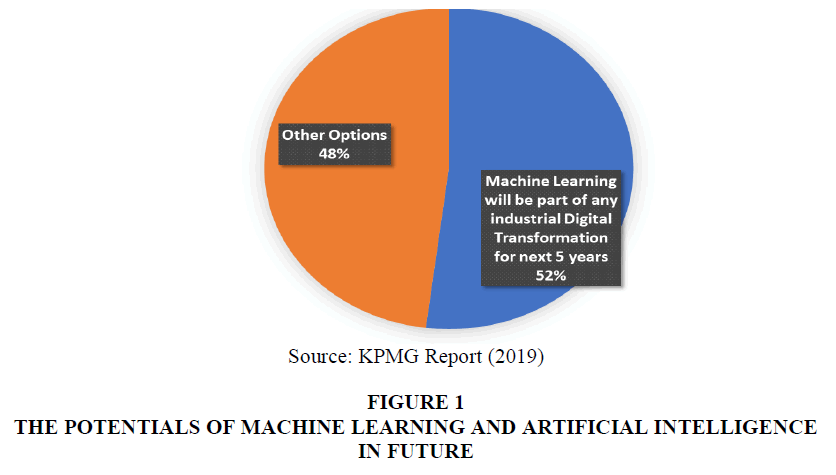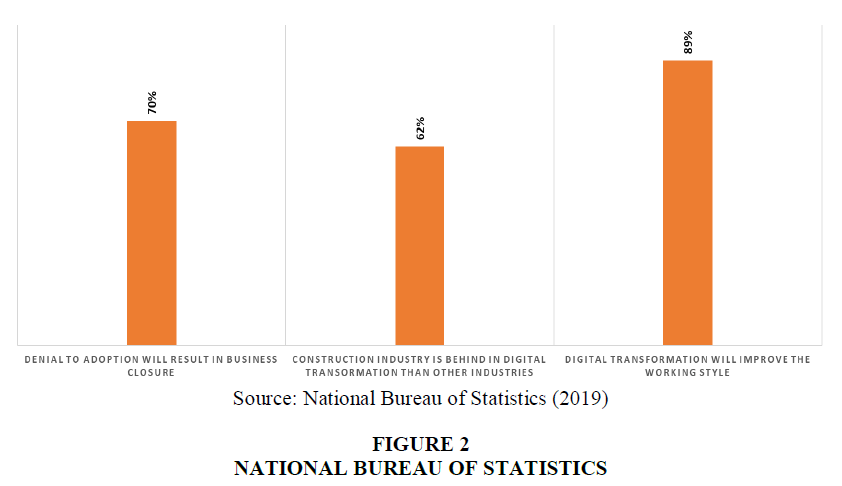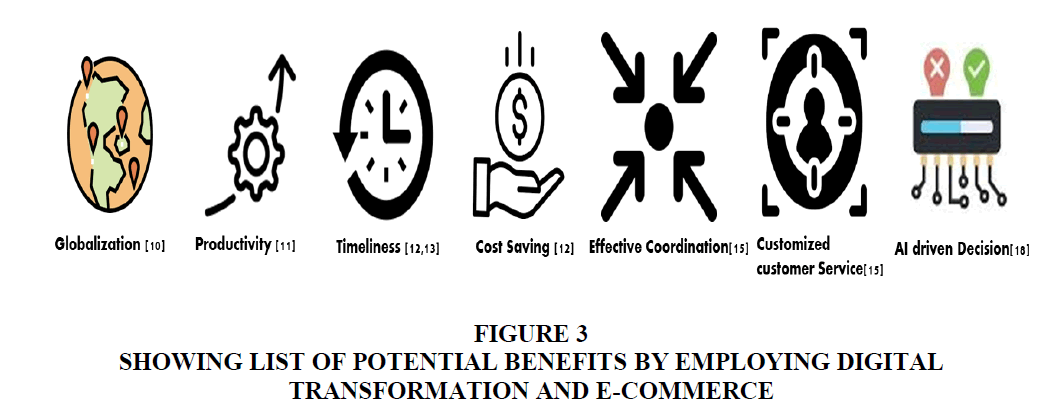Research Article: 2021 Vol: 20 Issue: 1
Digital Transformation and E-Commerce in Construction Industry: A Prospective Assessment
Shabir Hussain Khahro, Prince Sultan University
Shafiqul Hassan, Prince Sultan University
Noor Yasmin Binti Zainun, Universiti Tun Hussein Onn Malaysia
Yasir Javed, Prince Sultan University
Abstract
The 2020 has been a challenging year, disrupting firms in all markets and leaving global instability. Digital adoption using e-commerce, automations needs to be adapted quickly especially in construction. The delay in adoption will make the construction industry lag behind other fields and will require revamping and huge investments to have a competitive level if delayed. It has been observed that Construction industry lacks in digital transformation and E-commerce applications. Therefore, this paper evaluates the possible potentials of digital transformation and E-commerce in construction industry. A detailed literature review has been carried out to analyze the possible potentials, benefits and barriers of digital transformation and E-commerce in construction industry. It is concluded that with the application of Information Communication Technology (ICT) and other innovations, the overall productivity, efficiency and competitiveness will increase in construction industry. Digital transformation and E-Commerce applications facilitate the flow of work and collaboration at different organizational levels. For large and small companies, ICT and e-Business are essential for promoting incorporation and cooperation with business associates, vendors and consumers, as well as making electronic transactions. It provides consumers with support, helps produce and accept sales and orders at a fast level, lowers inventory time, costs and decreases obsolescence. Maintenance of the framework, stability and lack of software expertise are the few obstacles in the construction industry's use of E-Business. Application/Improvement: For the growth of e-Business in the building industry, collective and full collaboration is needed.
Keywords
Digital Transformation, E-Commerce, Hybrid Procurement, Construction Industry, Business Approach.
Introduction and Literature Review
Although most construction industry will find a variety of IT services, these usually contain just fragments of the latest range of E-commerce systems. The explanations for this include the large degree of expenditure needed for these programs to work, the volatility of the returns on these systems, and the new ability sets required for workers to function. However, it is evident that as E-commerce platforms become more profoundly ingrained in the construction industry, it would be important to resolve these barriers. The benefits are significant and they would flow to all stakeholders. The creation of an information management role for one or more of the professional groups is another likely outcome of the use of E-commerce in the construction industry. In securing such a role, the construction profession needs to be proactive. The COVID-19 pandemic results in higher disruption and the professionals in the construction industry are expecting to boost the investments in digital transformation and E-commerce. When it comes to disruption-driven digital investments, the construction sector beats all others and e-commerce is at the very heart of this digitization. This is a product of market preference, a paradigm shifts in how the business runs, and the reality that the industry as a whole is lagging behind when it comes to digitalization. In a recent survey conducted by Klynveld Peat Marwick Goerdeler (KMPG) in 2019, it is reported that machine learning and artificial intellegance will be adopted normally in this sector in next five years as shown in Figure 1.
Another recent survey conducted by National Bureau of Statistics, 2019 reported that 70% of constuction companies perseive that they will be out of business market if they will not adopt to digital transformation and E-commerce era. Whereas, 62% experts believe that the construction industry is way behind the other industries in terms of adopting digital transformation and E-commerce solutions. It is also reported the sruvey that almost 89% of the experts feel that the digital transformation and E-commerce will transform this industry and the productivity and profitibility can be incearsed using the applications of digital transformation and E-commerce as shown in Figure 2.
The estimated size of the global demand for building materials by 2030 is expected to be one trillion dollars (Castillo, 2020). It will help the practitioners draw on a greater share of those gains through an online distribution platform. In the building sector, demand for e-commerce is much greater than the cross-industry average, which is why as many as 84 percent of industry firms plan to offer 100 percent of their goods digitally in the future (Castillo, 2020).
The developments in digital technologies opened the way for internet retailers to be set up to satisfy shoppers' demands, just as a brick and mortar shop might do. This method of buying and selling goods and services over the internet through online platforms is known as E-commerce. The Internet-based procurement and distribution of products and services is more generally referred to as E-commerce. Although this is still common in the retail sector, E-commerce in the construction industry has also grown steadily. The various advantages of E-commerce given in the following sections, particularly for the vendors. Another way of thinking about E-commerce is literally to do it digitally. This covers, for example, the purchasing and distribution of digital cash goods, but can also involve the exchange of products, products and services. In other areas of the economy, E-commerce is commonly employed, and examples include airline booking services, Internet banking and online shopping malls. Any of these technologies, such as automated banking, are more apparent to the public. Online banking has expanded exponentially, and resources such as accounts, account changes, bill payments, loan approvals and investment preparation can now be used by consumers (Stewart, 2001). Using this concept, with catalog shopping and home shopping using cable TV, E-commerce has several parallels. But this concept of on-line purchasing and sale is not restricted to E-commerce only. It also contributes to major improvements, affecting all facets of a company and business, in the way goods and services are delivered and shared. With its influence on three distinct categories of business processes, the true disruptive value of E-commerce is a) within-business processes, b) business-to-business processes (e.g. supply-chain management) and business-to-consumer processes (Johnson, 2000).
By engaging in technological advancements, other sectors have increased efficiency. In this pattern, the rise of the Internet and business-to-business E-commerce promises a continuous rise. As the usage of the Internet has grown, the idea of E-commerce has expanded (Johnson, 2000). Online tendering, online recruitment, online project coordination and correspondence, online sales, online contracting arrangements, online payment, and online database systems are among the forms of resources that can be enabled using technology and E-commerce. For the building sector, E-commerce may seem like an exotic idea. It has been embraced as this concept can boost the revenue. But it is still challenging for E-commerce to seep into the conventional construction industry. This aversion has many explanations and the best one is the ease of doing business. For a construction firm, E-commerce implementation is not easy. The growth in E-commerce is steadily gaining traction in this industry (CMGurus, 2019).
New ICT and E-Business innovations are introducing improvements to the building sector. ICT applications facilitate the flow of work and collaboration at different organizational levels. For large and small companies, ICT and E-Business are essential for promoting incorporation and cooperation with business associates, vendors and consumers, as well as making electronic transactions. It provides consumers with support, helps produce and accept sales and orders at a fast level, lowers inventory time, costs and decreases obsolescence. Business companies are starting to implement speedy contact tools in the current scenario to get productive job completed. Small and Medium Enterprises (SMEs) in the building industry contribute greatly to the growth of the economy. While it has the greatest potential for growing growth and performance, the usage of information and communication technology in this field is limited. E-tendering, E-site, E-procurement, and E-quality are the four most relevant internal ICT systems. However, the absence of technical skills contributes to ignorance of ICT implementation programs at different levels in the building industry (Vitkauskaite & Gatautis, 2008; Harindranath, 2008).
Based on the significance of this key research area, this paper evaluates the potential effectiveness of digital transformation and E-commerce in construction industry as it has huge potentials to improve the productivity and work processes in this industry. This paper also presents the possible benefits of digital transformation and E-commerce in this important industry. In the last phase of this paper, the potential barriers in adoption of digital transformation and E-commerce are also highlighted in this paper. This paper highlights the potential benefits of this new era of digital transformation and E-commerce. It will provide the benchmark for researchers working in this field as it the growing field these days and there is huge potential for young entrepreneur in all industries including construction industry. This paper will provide the initial platform to promote and implement digital transformation and E-commerce in construction industry to improve the construction processes and the supply chain management cycle in this industry.
Benefits of Digital Transformation and E-commerce
All of the stakeholders in the construction process can benefit in some manner from the introduction of digital transformation and E-commerce. Some of them are shown in Figure 3 the possible benefits are as follows;
• Globalization: Expanding the market places to national and global level (Mohamed, 2010).
• Productivity: Increases productivity in construction (Issa et al., 2003)
• Time: Effectively Using the time by reducing the error, rework, reduce hard copy storage (Al-Weshah & Al-Zubi, 2012). Cost: Reduction in business process cost
• Communication: Retrieve accurate information about the project at a greater speed from various locations (Mohamad & Ismail, 2013)
• Revenue: Increase in the profit and turnover of the company (Agboh, 2015).
• Coordination: Effective coordination and collaboration (Khan, 2018)
• AI driven decision: Decision about cost, order placement can be supported by Machine learning allowing effective and in time decision (Agboh, 2015; Khan, 2018).
• Customized customer care: AI based solution will allow focused customer care according to their preferences, it will also allow prediction about upcoming purchases and market condition thus allowing auto-order placement before time (Issa et al., 2003; Jabeur, 2013)
• Customer Service: Keep better relation with the customers (Jabeur, 2013)
• Workforce Motivation: Employees are motivated with proper communication (Jabeur, 2013)
• Investors: Improved project transparency and improved risk management
• Owners/Developers: Lower contingencies, increased project efficiency, reduced construction cost, reduced construction periods
• Designers and other consultants: Time savings, improved communications, accuracy and specification
• Contractors/Sub-contractors: Lower costs, time savings, increased control, enhanced communication and procurement processes
• Suppliers: Lower inventories, reduced costs as well as due to automated stock report and supplier report the orders can be made before time to suppliers to avoid any delays.
• Manufacturers: Reduced supply chain costs, improved information, purchasing and supply processes. Equipment rentals and sales Deliver orders quickly, Low wastage & environment-friendly, Budget, and financial management, E-commerce through mobile.
• Accident control: It will allow taking decision timely and according to government guidelines. Moreover, digital transformation will allow in-time reporting resulting in less number of accidents (Khahro, 2016)
The influence of digital transformation and E-commerce is even greater than the benefit of improving transaction processing efficiencies, changing the systems utilized in many sectors. It is now evident that E-commerce would bring big improvements for enterprises, customers, the government and the environment. Companies are improving the work processes of the company.
Key Barriers for Digital Transformation and E-Commerce
Lack of staff to support the technology
There is the dire need for the digital transformation in the construction industry, but there are some barriers that are to be addressed, one of the barrier is the lack of trained manpower who have the expertise and knowledge of both construction industry and the e-commerce.
Budget
Budget is another factor that creates the hindrance in the digitalization of the construction industry. Most of the contractors are from the middle or small level background and they lack excessive amount of profitability that can be invested for retaining their commercial online presence.
Employee hesitance
Construction is the labor intensive industry, most of the workers are not well educated and those who had got some education, degree or diplomas are mainly related to civil engineering and it lacks the teaching of Information Technology and business expansion. Therefore, the employee is not comfortable with the IT tools and approaches. They feel comfortable with the existing tradition constructing practices.
Management hesitance
Similar to employee hesitance most of the higher management, proprietors and field supervisors are reluctant in the adoption of digitalization in the construction related business, there are several reasons to it but few main resistances are as follows: Lack of entrepreneurial skills, Incompetence in digitalizing the business structure and Reluctance and lack of confidence in retaining the e-commerce model of their business.
Lack of knowledge about new technology available
As discussed and depicted in the few earlier mentioned points one major issue in expanding and developing the online digitalized set up related to construction industry is the lack of knowledge about the new technologies available, the main reason is the lack of proper education, normally the courses that are taught in the construction industry courses are mainly technical and related to the same field. These courses lack the business and IT related aspects. So it is strongly recommended to integrate these knowledge oriented courses in the construction related courses and degree programs.
Lack of IT infrastructure
In most parts of the developing country, IT infrastructure is either weak or not available. There are several places where there is no internet and some places with still 3G internet services where the world is now shifting to 5G. Therefore, IT infrastructure improvement can also support the digital transformation and E-Commerce.
Lack in construction technology funding
In the third world countries there has been lack of investment in the construction related IT & E- Commerce industry, the reasons to this issue is the lack of infrastructure, lack of education and knowledge and old ways of awarding the tenders. The government institutions related to the construction industry are also not digitized and uses the old ways to carry out business.
Total negligence (Do not want to use)
Many construction industry-related individuals have limited vision of the productive opportunities of the construction industry's including digitalization and e-commerce. They continue to use the traditional methods of construction and procurement.
Conclusions
It has been seen that e-commerce is now being common in its usage and innovations in this field have already been undertaken by a variety of stakeholders in the building sector. The increase in Internet and e-commerce usage in Australia means that the building sector will become consumers of these innovations and will have a huge effect on the manner in which development takes place as this happens. It is estimated that one trillion dollars’ size of the global demand for building materials by 2030. And it will help you draw on a greater share of those gains through an online distribution platform. Bonus: the best e-commerce approach will also assist you to transition more gracefully to the future of disruption.
Using smart automation and e-commerce to maximize efficiency: it is within reach for businesses in the building sector. Maintenance of the framework, stability and lack of software expertise are the few obstacles in the construction industry's use of E-Business. Application/Improvement: The performance of e-Business in the building sector needs collective and full teamwork.
In conclusion, the growth of e-commerce in the construction sector is not a simple development, but rather it is the future of sales and has become a way for vendors to appeal to smarter customers who have ready access to knowledge. E-commerce has also culminated in quicker distribution of the materials needed for a project, as well as waste reduction. It also encourages building sector vendors to handle their budgets easier. All these advantages, together with the growing trend in e-commerce, have been realized in the building industry.
References
- Agboh, D.K. (2015). Drivers and challenges of ICT adoption by SMES in Accra metropolis, Ghana. Journal of Technology Research, 6, 1.
- Al-Weshah, G.A., & Al-Zubi, K. (2012). E-business enablers and barriers: empirical study of SMEs in Jordanian communication sector. Global Journal of Business Research, 6(3), 1-15.
- Castillo, D. (2020). 2021-Ready? Disruption, digital transformation, and e-commerce in construction. Retrieved from https://www.sana-commerce.com/blog/b2b-e-commerce-construction-industry-research/
- CMGurus. (2019). E-Commerce Rise in the Construction Industry: What are the Benefits?. Retrieved from https://www.cmgurus.com/e-commerce-rise-in-the-construction-industry-what-are-the-benefits/
- Harindranath, G., Dyerson, R., & Barnes, D. (2008). ICT in small firms: factors affecting the adoption and use of ICT in Southeast England SMEs.
- Issa, R.R., Flood, I., & Caglasin, G. (2003). A survey of e-business implementation in the US construction industry. Journal of Information Technology in Construction (ITcon), 8(2), 15-28.
- Jabeur, F., Mohiuddin, M., & Karuranga, E. (2013). Timeline of initial perceptions and adoption of e-business among Quebec forestry sector SMEs. Communications of the IIMA, 13(3), 1.
- Johnson, R.E. (2000). The impact of e-commerce on the design and construction industry.
- Khahro, S.H., Ali, T.H., Javed, Y., & Talpur, M.A.H. (2016). Identification of Occupational Accidents, Health Problems and Causes: A Case Study of Cement Industry. International Journal of Civil Engineering and Technology, 7(6).
- Khan, A.S., Qahar, A., Fauzi, A.H., & Javed, Y. (2018). Using Green and Emerging Technology. Asian Journal of Information Technology, 17(1), 23-51.
- KPMG Report. (2019). Retrieved from https://home.kpmg/xx/en/home/campaigns/2019/12/global-annual-review.html
- Mohamad, R., & Ismail, N.A. (2013). The extent of E-business usage and perceived cumulative benefits: A survey on small and medium-sized enterprises. Information Management and Business Review, 5(1), 13-19.
- Mohamed, I.S. (2010). Empirical Study On Factors Determining E-Business Usage On Business Performance In Malaysian Service Industry. Unpublished doctoral dissertation, University of Multimedia.
- National Bureau of Statistics. (2019). Retrieved from https://www.nigerianstat.gov.ng/
- Stewart, P. (2001). The role of e-commerce systems for the construction industry. Construction Economics and Building, 1(2), 24-36.
- Vitkauskaite, E., & Gatautis, R. (2008). E?procurement perspectives in construction sector SMEs. Journal of Civil Engineering and Management, 14(4), 287-294.


